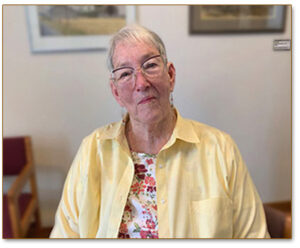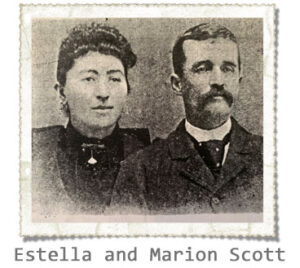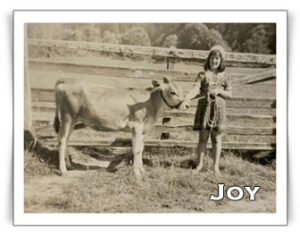The 4-H Fairs were always held in July (the hottest month of the year).
“The only respite was to keep one’s feet in cold buckets of ice water!”
 I looked forward to sitting with Joy McCourt for this Oral History interview with much anticipation. I was aware Joy came from a well-established Fiddle Creek pioneer family. They had been homesteaders who worked hard to create a life for themselves and their families. Having grown up on her family’s dairy farm, she was generous in sharing experiences of a life rich with pioneer history.
I looked forward to sitting with Joy McCourt for this Oral History interview with much anticipation. I was aware Joy came from a well-established Fiddle Creek pioneer family. They had been homesteaders who worked hard to create a life for themselves and their families. Having grown up on her family’s dairy farm, she was generous in sharing experiences of a life rich with pioneer history.
The story unfolds during the Fall of 1892 when Marion D. Scott of Iowa first met Estella (“Stella”) Miles of Fiddle Creek while in Independence, Oregon picking hops. Their paths would soon cross again. That Fall, Marion came to Fiddle Creek for duck hunting and made a point of  becoming more acquainted with Stella. Following a courtship, they married in 1893 and lived in Independence. Marion was a house painter and paper hanger, but began experiencing vision difficulties. Joy suggests it was likely attributed to lengthy exposure to glare from the white paint commonly used for homes at that time. in 1897 they moved to Fiddle Creek where Stella’s family lived, settling on a homestead in Upper Fiddle Creek. There they raised 6 children on their farm – 3 born in Independence, and 3 in Fiddle Creek. Joy’s father, Glenn was their youngest son.
becoming more acquainted with Stella. Following a courtship, they married in 1893 and lived in Independence. Marion was a house painter and paper hanger, but began experiencing vision difficulties. Joy suggests it was likely attributed to lengthy exposure to glare from the white paint commonly used for homes at that time. in 1897 they moved to Fiddle Creek where Stella’s family lived, settling on a homestead in Upper Fiddle Creek. There they raised 6 children on their farm – 3 born in Independence, and 3 in Fiddle Creek. Joy’s father, Glenn was their youngest son.
Growing up, Joy recalls the milk was transported in cans and sometimes went by train to the creamery in Cushman. To keep the milk cool, the cans were placed in the creek. A milk truck returned the empty milk cans to the farm and also picked up full cans. Her father kept the herd size at 22 cows, finding it to be ideal for their farm size. Milking was done twice a day, every day. Generators were used for power to run the milking machines.
Farm Chores
When asked if milking the cows was part of her chores, Joy smiled and admitted to having enjoyed the milking. As a senior in high school, she often rushed home to do the 5 o’clock milking so her father could attend school activities and sports games of her younger siblings.
She said the time to complete the milking varied, as some cows “simply milked faster than others – and you just couldn’t hurry them!” Usually, the chore took about 2.5 hours including cleanup. (Hosing down the milking parlor, cleaning the strainer, milking machines, etc.)
4-H
 Joy received a number of ribbons for exhibiting young heifers for 4-H. Years later, her children also participated in 4-H, and at the Lane County 4-H Fair, brought home ribbons of their own. The Fairs were always held in July (the hottest month), and as Joy puts it, the only respite was to keep one’s feet in cold buckets of ice water!
Joy received a number of ribbons for exhibiting young heifers for 4-H. Years later, her children also participated in 4-H, and at the Lane County 4-H Fair, brought home ribbons of their own. The Fairs were always held in July (the hottest month), and as Joy puts it, the only respite was to keep one’s feet in cold buckets of ice water!
School
Fiddle Creek had a 2-room rural school, which Joy attended through the 8th grade. Until the 6th grade, she was the only student in her class. In grades 1,2, 7 and 8, the teacher was her grandmother, Laura Luttrell. Much like other rural students, after completing the 8th grade, Joy attended school in Florence. However, with no bus service, students from rural areas stayed with a host family in town during the school term. At 14, during her freshman year, she boarded with a family in town with 4 children. Joy’s chores were to help take care of the children, in addition to housework and ironing clothes. With that many children, she was kept busy, and claims to have “gotten really good at ironing”. On weekends, she returned to her family’s farm. The next year, in 10th grade, a bus service was established. She was then able to live on the farm and ride the bus to school in Florence. She graduated in 1955 from Siuslaw High School.
Alderwald Farm
Joy married her high school sweetheart, John W. Smith, started a family and worked on their Alderwald Farm (“Little Green Valley”), which was then across from the old Fiddle Creek School. The farm was a 3-way partnership, with John, his brother Tom, and their father. They milked 125 dairy cows with an automatic pipeline system, capable of milking 6 cows simultaneously. According to her, at one time their farm was known as the largest dairy in Western Lane County. Half of their cows were Holstein and the other half were Jersey. As she explained, the greater the butterfat content, the higher the price, so having Jersey cows assured the farm’s butterfat yield would be high. The Holsteins produced a larger quantity of milk, allowing the farm to reach the required quota (percentage of their production) of milk. This was important in order to receive payment for the agreed upon price. By comparison, Joy says her father’s dairy had changed to an A-grade dairy, with all Jersey cows and was therefore paid a premium price for the richer milk.
Floods, Slides and Storms
Each winter floods completely covered their fields. Unable to allow the cattle out onto the flooded fields, they were placed in loafing sheds from the middle of November until the middle of April. Sand and wood shavings from the mills were placed in the stalls. “Maternity” stalls were setup for the cows who had calves each year, and the calving allowed them to continue to be milked (or they would dry up).
In a 1975 interview for the museum, Joy’s mother Lilah, described a big slide that “took all of the top soil; just went right down to the rock . . . It took my husband 4 or 5 years to get that restored”. “We had 40 days of continual rain, and it frosted hard. As the ice on the ground melted, it loosened the soil clear down to the bed rock”. Back then, creek water was used for irrigation and was initially pumped by diesel, until the introduction of electricity. Joy recalled a regular and annoying occurrence during major storms, was that power would be out for 5 days or more.
Grange Hall
The Grange has always been important, and is what Joy describes as a “special place”. It initially served as a meeting place to help farmers improve their lives, organize, and lobby for better market prices for their crops. They urged County Commissioners for better roads, such as Canary Road, which was previously just potholes in the gravel. The Grange also became a community social center for potlucks, and school or holiday events (dances, weddings, memorial services). Like her parents who met at a Grange Hall dance, Joy met her husband at a square dance there, as well. Chances are, it was at a Grange event where many of the folks in the area first became acquainted with their spouses.
Sadly, Joy’s husband John, passed away in 2001. Joy later married Alan McCourt. Recalling past social events, Joy fondly remembers the big box socials. Women would prepare an evening meal in decorated boxes which were auctioned off at Grange events. Whomever won a box, ate supper with the donor of the box. The pie socials were celebrated in a similar fashion. Pies were auctioned, and the winner shared a piece with the baker.
There is no doubt the pioneers were courageous to leave behind a life for new beginnings in areas often far and unfamiliar to them. Their resilience to overcome challenges (weather, floods, etc.) time and again, is a testament to their determination and hard work. Learning about their lives takes our own thoughts back to a lifestyle somewhat difficult to imagine. Their legacy is what the Oral History Project celebrates with each story. It was an honor to interview Joy McCourt, a pioneer family member with an abundance of history and historical knowledge.
Interview and Story by Deb Lobey, 2023
Transcript by Suzanne Korosec
Audio, Story and Transcript available for review in the Museum’s Kyle Research Library
